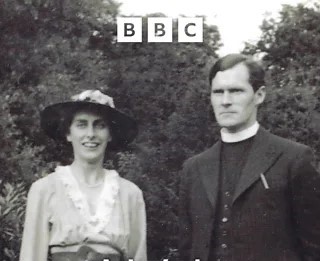| Lives of Painter and Poet Explored |
Love’s Moment: R S Thomas and Mildred Eldridge |
| Gwyneth Lewis , Radio 4 and BBC Sounds , October 16, 2025 |
 Gwyneth Lewis' premise for her programme is simply put:
Gwyneth Lewis' premise for her programme is simply put: “What happens when two artists fall in love and marry? Then one's reputation soars while the other is forgotten. Has her reputation been unfairly eclipsed?” The character of R S Thomas has a reputation. “He searched for a Wales he could love and was harsh when he didn't find it.” Gwyneth Lewis remembers that she interviewed him when she aged twenty. She approached the meeting with some apprehension. In the event he turned out to be warm and charming. The childhood of the future poet was of a nature that carried through his conception of marriage. When asked “Did you love Elsi deeply?” and replied “I don't think I'm a very loving person.” Tony Brown of Bangor University recalls that a one-woman show by Elsi Eldridge at the Beaux-Arts Gallery was a success. She bought herself a Bentley. R S Thomas' early poetry was whimsical and Georgian. It was she introduced him modernism, to Yeats, Eliot and Joyce. Her diaries are in the R S Thomas Centre in Bangor and have not been published. Her tone is direct. In Manafon the pair had goats and grew fruit. There was space in the rectory for both artists to work. Their son contributes. ““There was no expression of sentimentality, of affection, of love, of touchiness. They were like the ice king and the ice maiden. But not unfond of each other. It was electric, the atmosphere in the house. But it was an electricity of separateness.” Gwyneth Lewis says that both had a deep need for privacy in order to work. The diary says “keep your hearts together but tents separate.” “Noiselessly they conversed” observes their son again. “They didn't need to talk. The deep emotional attachment meant they did not natter.” Gwyneth Lewis goes to see the mural “The Dance of Life” held in Ellesmere College in Shropshire. Peter Lord is with her to comment on the ruralism which was more redolent of the 1930's than the 1950's. The distaste for the modern world was a marriage of minds. The two see an artwork full of anxiety. It was a highpoint of her public art and she turned thereafter to small water-colours of the natural world. R S sought an idealised version of Wales and they moved west. She wept on their leaving of Manafon. In 1954 they moved to Eglwys-Fach. It was a community of “retired military and tea-planters. The army people were arrogant, belligerent, wealthy and self-important. And the others dull.” The rectory was cold and damp with no light for painting. R S was involved in cricket and danced with skill at a village Twmpath. The parishioners hardly saw her. Gwyneth Lewis meets some of them and asks "Do you think she was lonely?” “She was definitely lonely” is the reply. They move further west to Aberdaron. Her son attests she made a steady income all her life but became increasingly reclusive. “They shared a domestic life together that made both their art possible. She paid more of a price, a familiar story for women artists.” R S Thomas declined an interview after her death to discuss the art. Her legacy is now being considered, says Gwyneth Lewis, alongside that of her husband. “Love’s Moment: RS Thomas and Mildred Eldridge” can be heard at: https://www.bbc.co.uk/sounds/play/m002jf3b Note: The reason for the journey of the mural from a public setting in Glyndŵr University to the present location is not known. |
Reviewed by: Adam Somerset |
This review has been read 54 times |
